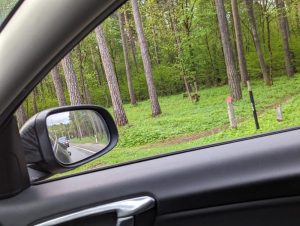[This story contains spoilers from Netflix’s American Primeval.]
“We do believe that people, if they want to understand where we’re at today, should look at where we were then,” director Peter Berg told a small room of reporters last October, as he, executive producer Eric Newman and Indigenous Consultant Julie O’Keefe, gathered at Netflix’s L.A. office as part of an early look at their project American Primeval.
The Western drama, which debuted Jan. 9 on Netflix, is less interested in Hollywood’s historically rose-colored, inspirational, adventurous — and sometimes even melodramatic — telling of America’s founding. Instead, the six-episode miniseries is more focused on how people and their explicable and inexplicable violence shaped a moment in U.S. history that ultimately led to the forging of a nation.
Set within one of the more brutal and uncompromising periods of American history — the 19th Century Westward expansion — the show depicts the run-up to and fallout around one of the biggest recognized mass murders in American history, the Meadows Mountain Massacre, as well as the transfer of power at Fort Bridger from army scout and mountain man Jim Bridger to the Mormons.
The multi-day execution took place in what was then the Utah Territory amid a war over land and autonomy between religious leader and territorial governor Bringham Young, followers and militiamen tied to the Church of Jesus Christ of Latter-day Saints, the U.S. federal government, frontiersmen, settlers, and involving Indigenous communities like the Southern Paiute, Shoshone and Ute. Led and carried out during the fall of 1857 primarily by a local militia made up of LDS members, with some support from Southern Paiute peoples, the mass murder resulted in the death of over 100 in what is now known as southern Utah.
“This was a very violent time in American history,” Berg told The Hollywood Reporter ahead of the premiere. “It certainly wasn’t the only violent time in American history. We have a long history of violence in this country and on this planet, and violence was something that [screenwriter] Mark L. Smith and I wanted to explore. The more we dug into that, the more we read, the more the realities of that violence became apparent.”
The massacre serves only as the series’ inciting incident, with Berg’s team largely unabashed in its depiction of not just that moment, but the larger survival efforts of the Indigenous, Mormons, soldiers and settlers during this bloody and blistering period. “This is how we started: chaos, war, guns, violence,” Newman told press during that October event. “To tone that down, I believe, we’d fall into the same trap of a lot of the nostalgic history westerns.
“The truth of this world is violent, and in the world that we’re living in today, that truth is no less a reality,” noted Berg. “But it was, at that point, an extraordinarily violent time.”
Through a series of interviews at press events and separately with THR, Berg, Newman, O’Keefe and several American Primeval cast members discuss how they leaned on historical accuracy and their creative instincts to deliver Hollywood’s latest rendering of the violence that made, and is still making, America.

Kim Coates as Brigham Young (left) with Alex Breaux as Wild Bill Hickman in American Primeval.
Courtesy of Netflix
Real History and a Healthy Skepticism of the Hollywood Western Inspired American Primeval’s Approach
Initially looking to take up a project in the vein of the 1972 Robert Redford film Jeremiah Johnson, Berg and an already onboard Newman reached out to The Revenant screenwriter Smith. In his office, Berg used an ice axe to pitch Smith on a collaboration, which would eventually follow a fictional frontiersman and mother-son duo navigating the Westward expansion. And that would lead the team to the true event at the center of the miniseries.
ERIC NEWMAN (EXECUTIVE PRODUCER) When we went about creating this world, [we wanted] authenticity — not just in depiction and representation, but also in the events and the people.
PETER BERG (DIRECTOR) We discovered the Meadows Mountain Massacre, which is something we knew a little bit about. Not a lot. That brought us into an interesting opportunity to explore Brigham Young, the Mormon religion, and how they were trying to survive — and violently so. Which is something I didn’t understand as well as I do now.
NEWMAN I grew up to a certain degree on [Westerns] and love them but there is a sanitized take on what was [an] incredibly violent era. The title [of the show] itself, American Primeval — this is the beginning of who we are. We’re seven years away from the Civil War. This is an incredibly violent period that hasn’t really stopped. You go to Europe and realize how different they are from us in their relationship to guns, violence, the celebration of our heroes.
JULIE O’KEEFE (INDIGENOUS CONSULTANT) In sugarcoating history, we really miss a lot in who we all are. All of our communities and cultures had some form of this. The interesting part is, [when watching this series], [the show] is tame compared to what it truly was. All of us were fighting for life and not a good life… We were trying to figure out as Natives how we were going to survive in this life that was coming in and being forced on us.
BERG As we did our research, [we] started to understand what was happening between some of these native tribes, the Shoshone, the Paiute, the Ute; the Mormons, the Mormon militia, which is the Nauvoo Legion that Brigham Young started because the Mormons were getting killed and chased all over this country and were holding their ground in Salt Lake City; and the U.S. military who is there trying to get the Mormons out and wreaking havoc on some of the Native American tribes that we’re showing.
NEWMAN The frontiersmen like [Jim] Bridger give way to ideologues like Brigham Young, who were able to marshal the many. And obviously, the Native component was essential — these real tribes that still exist, although nowhere near the state they were in — to tell this story about this battle for what this place would become.
BERG Our approach was to try and present these different people as nonbinary, nuanced communities. It’s about different disparate groups — different Native American tribes, different Mormon settlers, pioneers, mountain men, and U.S. military — all of whom were struggling to survive. And in that struggle for survival, they were at odds with other groups who were struggling to survive because no one felt as though there was enough oxygen in that space.
So everyone was trying to get theirs to protect their families, to protect their own. That desire to protect, which we still see today everywhere on this planet, leads to violence, leads to people committing acts of violence on other people because they’re terrified. What we tried to get at with these characters was these groups’ collective fear as a justification for the violence.
IRENE BEDARD (ACTOR, CHIEF PINE LEAF) In this project in particular, the unabashed truth — the dirt and the grit and the brutality — all comes together. This violent wave of humanity is something that I think is important for people to see. All Americans come from this brutality, and it’s not very many generations away. This is what we were built on.
NEWMAN Thematically, it was important to us that we are holding up something of a mirror.

The scalping sequence in the American Primeval premiere. Pictured: Dane DeHaan.
Matt Kennedy/Netflix
American Primeval Is “Factually Accurate,” Says Its Director, But It Also Relies on Fictional Composites to Tell Its Story
Berg and others went to the site of the Utah massacre, which they toured with Mormon historians, and brought on Indigenous consultant Julie O’Keefe, who guided the production across departments. But when recreating the violence of the massacre and some of the conflict’s key players, American Primeval leaned on real-life and fiction for characters, events, and even its violence.
NEWMAN I think history is pulp nonfiction, if you really look at some of the things — some terrifying — that have happened. The Meadow Mountains Massacre was one of these things.
BERG We’re writers and filmmakers, and so one of our skill sets is to imagine what that violence must have really looked like and felt like. That’s something that we tried to portray in that event, in the first episode, and subsequent events later in the series.
NEWMAN Taylor [Kitsch]’s character, Betty [Gilpin]’s character, are composites of the people who passed through here. A character that we developed in the process called [Captain] Dellinger was an easterner, West Point graduate [in the] U.S. Army who brought a certain introspection to this madness, and he serves a bit as a chorus. He’s based on John Gunnison, who came West at this time and looked at the Natives, looked at the Mormons, and had an enlightened take on it. Eventually, the Mormons felt he had betrayed them, and he was killed. Not to foreshadow the end of Dellinger, but there was this great message that the enlightened are not welcome here.
BERG In addition to the work we did to try and get it as right as we could with the Native American tribes represented, the Mormons [are] big in this as well. I think there are concerns about who the Mormons were and who the Mormons weren’t. People saw Book of Mormon and had a lot of fun with that, but if you’ve seen Book of Mormon, you realize it wasn’t a comedy. It was a pretty intense satire.
KIM COATES (ACTOR, BRIGHAM YOUNG) I was familiar, but not that familiar with the Mormon religion, Joseph Smith, Brigham Young, the prophecy and the Prophet. So there were all these books that I read to try and get into this guy’s head. When Joseph Smith was murdered in an Illinois prison, he was 34 years old. Brigham Young and the 11 other apostles had to draw strings to see who was going to talk to be the next prophet. Brigham Young won that out, and as the story goes, his voice that day sounded like Joseph Smith.
He saved that religion going from Missouri over the mountains to finding the Utah salt flats. So there’s no question that Brigham Young is solely responsible for that religion, and to be responsible for an entire religion and flock of people — he calls his people the flock — you better have a bit of gangster in you. You better have a bit of power in you. You better have a bit of God in you.
SAURA LIGHTFOOT-LEON (ACTOR, ABISH PRATT) I didn’t base [Mormon settler] Abish off of a single person. But what I will say is that the Abish I brought to the screen was made from a lot of women in my own life, mixed with reading this book called A House Full of Females. It’s all these little notes that Mormon women would write in their diaries, on the back of milk cartons, or on whatever piece of paper they could find.
It was the more academic side of the research that I did. It was tragic, but it was also very enlightening to get a sense of what women who were Mormon, who lived in 1857, were like. A lot of it was also based on my grandmother who raised me when I was very young. She was really strong and could do anything. Same with my mother. I have these wonderful female figures who push me through life, give me life, and carry with me like generations inside me.
O’KEEFE No period production is 100 percent accurate, but you have to be confident in your Tribal consultants and production team working together to make it as authentic as possible.
DEREK HINKEY (ACTOR, RED FEATHER) [Shoshone warrior] Red Feather is based on my family. I’m a direct descendant of War Chief Numaga, son of Chief Winnemucca, son of Chief Truckee, leaders of the longest, deadliest Indian wars in U.S. history. Numaga was who he’s really based off of, and Numaga was called a war chief by the people, but he prayed for peace. He was taught at a young age that when people come across and they’re light-skinned, you take care of them.
But with all the conflicts going on, he couldn’t, so he went into ceremony at Pyramid Lake [in Nevada], and he prayed for three to four days. When he woke up, he told the people, we have to go to war. But when they come, they’re going to come like sand in a whirlwind. So everywhere I go, I take my book on my grandpa, Sand in a Whirlwind: [The Paiute Indian War of 1860]. That’s what I draw from, especially for a character like this, to remind me that there’s that genetic memory, there’s that power inside.
BEDARD My character is based on a real woman named Pine Leaf [Woman Chief], who went into battle. In many of the tribes, it was the women who decided whether war was going to occur or not. The Cherokee — the Chalakee — had the Beloved Women. They’re an Eastern tribe. This is the Western Shoshone, but this idea that “She couldn’t possibly be the Chief,” and “Do we really have to talk to this woman about this?” The role of the matriarch and the matrilineal qualities of Indigenous peoples have been colonized so much in other depictions of the Western genre.

Betty Gilpin as Sara Rowell (right) with Preston Mota as her son Devin Rowell.
Netflix © 2024
Exploring Fact and Dramatization Helped the Team in Their Intentional Choices About What Violence They Depicted and Why
American Primeval isn’t shy about showing audiences violence of varying kinds onscreen, from the mass murder event — which depicts the killing of children — to an intense scalping sequence. But Berg, members of his crew and creative team, as well as the cast carefully considered what those illustrations of violence would mean, both in terms of how they filmed and what they filmed. That includes two assault sequences that avoid graphic depictions of rape, even when they both end in killing.
BERG I’ve done films that have violence as a large component to them, and I’m often asked if is there a line. I always say, yeah, there is a line. I can’t always tell you what it is, but I sense if it’s been crossed. That was true in Deep Water Horizon, Patriots Day, and Lone Survivor. Those were all stories that were real events, and I had to deal with and work with the parents and the children of people who had died, who often asked that. And what I would always say is, “I believe I instinctively won’t. It’s something that we can talk about when you see an early cut of the film, and if you think I have, I will engage you in that conversation and adjust appropriately.”
TAYLOR KITSCH (ACTOR, ISAAC REED) If you watch Isaac, he never initiates [the fight] unless he’s defending the kids, Sara, or himself. So it was never violence for the sake of violence. Originally, we opened the show with some guys who were coming up to him, and he killed them for literally no real reason, which happened back then. If I wanted your coat, I would just take it. If I had to kill you to take it, it’s just what happened. But we would take those beats out because it wasn’t driving character, and it was violence for the sake of violence.
BEDARD I appreciate the look at violence against Indigenous women — and violence against women in general — which was not something that was really talked about, but MMIW (Murdered and Missing Indigenous Women) and MMIP (Murdered and Missing Indigenous Peoples) did not just show up in the recent decades. This has been systemic.
SHAWNEE POURIER (ACTOR, TWO MOONS) On set for my scene, there were very limited people, which I’m very thankful for. They didn’t have a full crew. Only people that were necessary and that needed to be on set. I’m very grateful for that because it was such a hard scene. It took a lot out of me. But the intimacy coordinator was so comforting and helpful. She made sure that I felt safe and comfortable. And for me, it was empowering to know that Two Moons was going to get out.
BETTY GILPIN (ACTOR, SARA ROWELL) Sara comes from a society where the wrong grammar choice, or lack of glove, or showing the wrong part of your ankle is shocking and horrifying. It’s sort of societally life-ending, making one wrong tiny little choice, and it feels like the stakes are so high having a person like that put into a world where she’s seeing people’s heads get blown off. Not only are there people showing their ankles, they’re showing their intestines. How stark and terrifying that must have been.
But I think there are selective moments where one’s imagination is more terrifying than seeing something on screen. I think episode three is an example of that. What happens to Sara was originally written where we did see what happens, that you were inside the tent with them. Pete and I talked about how in a series where we do see so much happen, this was maybe a time where we could choose to have the audience’s imagination be the most terrifying thing.
BERG Something that I thought would be appropriate is not necessarily seeing all of the assault. That’s a horrific experience. Someone being assaulted is horrific. But I felt less challenged by that than I did with the aftermath. Me trying to tell or understand what it would be like for a woman to recover from that — to have to immediately pick herself up and continue — I was unsure about that. Those conversations, and that work with Betty, were really profound experiences for me. Probably the most profound experience for me of the entire series.
***
American Primeval is now streaming all episodes on Netflix. Read THR‘s premiere interview with Dane DeHaan and finale interview with director Peter Berg.









КОММЕНТЫ